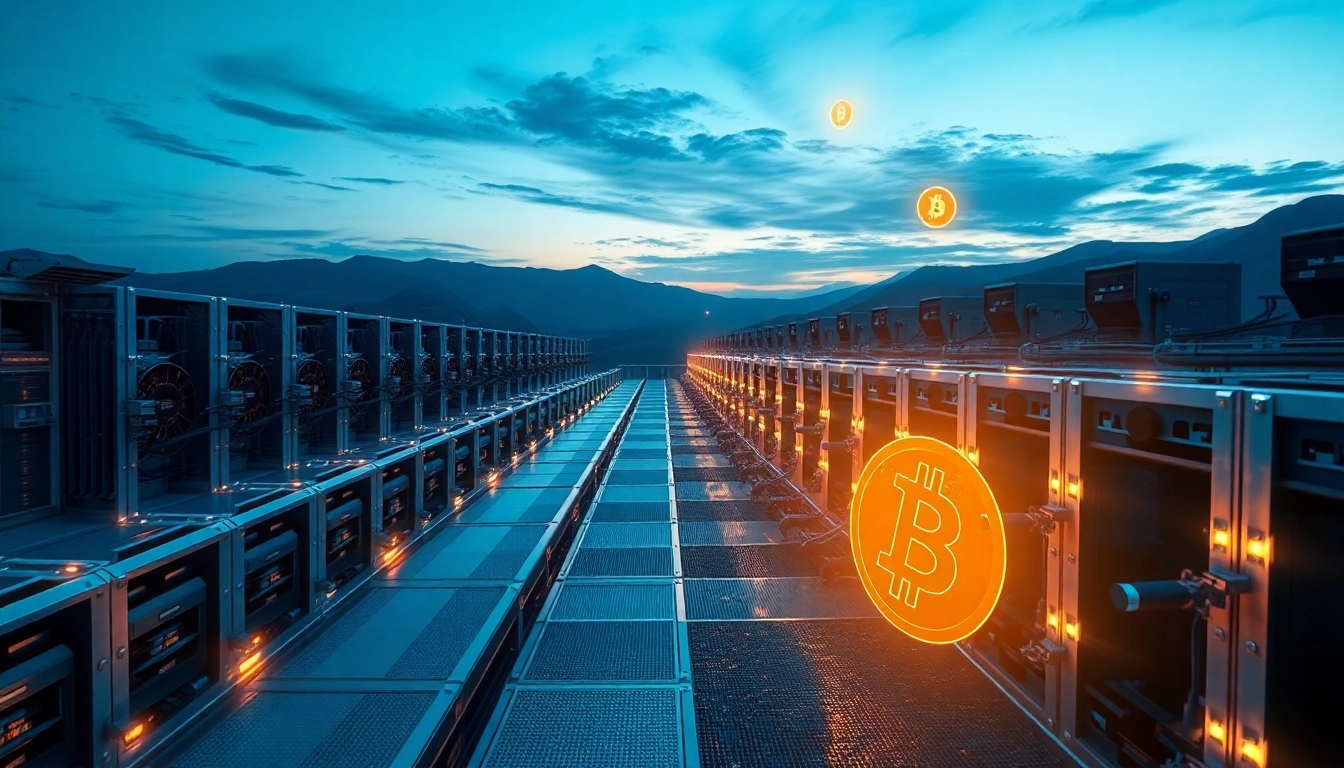Understanding Bitcoin Mining: The Basics
What is Bitcoin Mining?
Bitcoin mining is a fundamental process in the Bitcoin network that involves verifying and adding transaction records to a public ledger, known as the blockchain. As transactions are conducted on the network, miners compete to solve complex mathematical problems—this process results in new Bitcoins being created and transaction details being confirmed. It is a decentralized and safe method of maintaining the integrity of the Bitcoin system while rewarding miners with cryptocurrencies for their efforts. Essentially, Bitcoin mining is akin to a lottery system, where numerous miners attempt to provide proof of work that validates transactions, and only the first successful miner is awarded the block reward.
How Does Bitcoin Mining Work?
The mechanics of Bitcoin mining rest on a few key components: the blockchain, miners, and proof of work algorithms. When a Bitcoin transaction is initiated, it is broadcast to the network and collected in a list known as a block. Each block contains a header with information including timestamp, a reference to the previous block, and a nonce that miners must calculate to solve the mathematical puzzle required for block confirmation.
Once a miner successfully computes the nonce, they broadcast the block to the network. Other miners verify the block; if it is accepted, the block is added to the blockchain, and the miner receives a reward, which consists of newly minted Bitcoins plus transaction fees from the transactions included in that block. This mechanism not only serves to secure the network but also regulates the issuance of new coins and enforces the fundamental principle of decentralization.
The Role of Miners in the Bitcoin Network
Miners serve several critical functions in the Bitcoin ecosystem. They facilitate transaction processing by confirming and validating Bitcoin transactions. Without miners, there would be no way to verify whether the sender of a Bitcoin transaction actually possesses the amount being sent or if they are trying to double-spend. The efforts of miners also ensure the network remains decentralized, by allowing anyone with the right hardware and software to participate in mining.
Additionally, miners play a critical role in achieving consensus within the network. Any change to the Bitcoin protocol must be agreed upon by a majority of miners, which adds a layer of security and transparency to the system. The incentives provided to miners through block rewards and transaction fees encourage the continual investment in mining hardware and energy, helping to maintain network stability.
Getting Started with Bitcoin Mining
Choosing the Right Mining Equipment
To start Bitcoin mining, it is essential to select appropriate hardware. The mining landscape has evolved significantly since Bitcoin’s inception, and today, the most effective miners utilize Application-Specific Integrated Circuits (ASICs) engineered specifically for Bitcoin mining. These devices outperform traditional CPUs and GPUs in both efficiency and performance.
Potential miners must consider factors such as cost, energy consumption, and hashing power—all critical elements that determine mining profitability. For instance, popular ASIC models like Antminer or AvalonMiner can offer different levels of efficiency and performance at varying price points. Conducting thorough research on mining hardware specs and ensuring it aligns with the current market dynamics is crucial to making an informed decision.
Setting Up Your Mining Software
In concert with hardware, having the right mining software is equally important. Mining software connects your hardware to the Bitcoin network and begins the mining process. Some popular mining software options include CGMiner, BFGMiner, and EasyMiner, each offering unique features and interfaces that cater to different user preferences.
Once mining software is selected, users will typically need to set up a Bitcoin wallet where mined Bitcoins can be stored safely. Moreover, configuring the software will require attention to specific settings like pool connection, mining protocol, and performance monitoring. These configurations will allow miners to optimize their operation for better performance and profitability.
Understanding Mining Pools and Their Benefits
With increasing network difficulty and competition, solo mining has become less feasible for individual miners. Mining pools present an attractive alternative by allowing miners to join forces and share their collective computational power. In a mining pool, members combine their resources to increase their odds of successfully mining a block. Once a block is mined, the reward is distributed among members according to the contributed hashing power.
Mining pools can offer stability and predictable income, reducing the volatility associated with solo mining. Members can choose between various pools, considering factors like pool fees, payment structures, and payout thresholds before deciding which pool best aligns with their mining goals.
Advanced Techniques in Bitcoin Mining
Optimizing Hardware for Better Performance
After establishing their mining setup, miners can further optimize their hardware for improved performance. This can include overclocking mining rigs to increase hashing power. However, it is essential to balance this with adequate cooling solutions to prevent overheating, which can damage hardware or reduce its lifespan.
Additionally, regularly updating firmware and mining software can lead to performance enhancements and security improvements. Miners should keep abreast of the latest advancements in mining technology to stay competitive within the constantly evolving market.
Cloud Mining vs. Traditional Mining
Cloud mining has gained popularity as an alternative approach for individuals who want to participate in Bitcoin mining without needing to invest in hardware or manage energy costs. In this model, users rent or lease hashing power from a cloud mining provider who handles all aspects of mining operations.
While cloud mining eliminates many of the operational challenges that come with traditional mining, it is essential for potential miners to choose reliable providers and understand the terms of their agreements. There are risks associated, including potential scams and fees that can eat into profits. Consequently, comprehensive research and due diligence are critical when considering cloud mining options.
Understanding Crypto Mining Economics
The economics of Bitcoin mining is a crucial consideration for both novice and experienced miners. Understanding key metrics such as hash rate, energy costs, mining difficulty, and market price for Bitcoin can help miners determine profitability. The hash rate refers to the speed at which a miner can perform calculations, and higher hash rates stand a better chance of success in mining.
Energy consumption is another critical factor; miners often calculate a break-even point based on energy costs and potential earnings. Tools like profitability calculators can help miners assess different scenarios to optimize their mining strategy, ensuring they maximize their returns while minimizing expenses.
Common Challenges in Bitcoin Mining
Dealing with Rising Energy Costs
Energy consumption is one of the most significant operational costs in Bitcoin mining. As the network grows and difficulty increases, miners face heightened energy expenses that can affect profitability. Many miners seek locations with lower energy rates, such as areas with renewable energy sources or subsidies aimed at attracting mining operations.
Implementing energy-efficient practices, such as using specialized cooling systems or operating hardware during off-peak hours, can also help to reduce energy consumption and improve overall profitability.
Overcoming Hardware Limitations
Bitcoin mining hardware has a limited lifespan, primarily characterized by the continual advancement of technology. Miners must frequently assess whether their existing equipment remains competitive and may need to upgrade to newer, more efficient models regularly. Keeping track of technological developments in the mining space and new product releases can provide essential insights for making timely upgrades.
Additionally, engaging in preventive maintenance and conducting regular performance monitoring enables miners to avoid unnecessary downtime and mitigate the risk of hardware failures that can lead to lost mining opportunities.
Addressing Security Risks in Mining
Security in Bitcoin mining is paramount. Miners must ensure that their operations are protected against malicious attacks, particularly due to the potential for unauthorized access to hardware and wallets. Employing comprehensive security measures—ranging from robust firewalls to two-factor authentication—can help bolster defenses against potential threats.
Moreover, understanding the risks associated with mining pools and selecting only reputable operators is critical. Ensuring that hardware is kept up-to-date with the latest security patches can mitigate vulnerabilities and protect assets over time.
Future Trends in Bitcoin Mining
The Impact of Bitcoin Halving Events
Bitcoin halving events occur approximately every four years, reducing the block reward that miners receive for successfully mining a block by 50%. This phenomenon significantly impacts the supply of new Bitcoins entering circulation and influences market dynamics. Historically, halving events have led to increased Bitcoin prices as reduced supply combined with persistent demand drives upward pressure on market value.
Miners must factor these events into their long-term planning, determining whether they should expand operations prior to a halving or adjust strategies based on projected post-halving market conditions.
Emerging Technologies in Mining
The future of Bitcoin mining will be shaped by various emerging technologies. Innovations such as advanced cooling systems, enhanced ASIC designs, and even quantum computing pose significant implications for the mining landscape. For instance, solutions that use renewable energy technologies or repurpose waste heat could transform mining from an energy-intensive process into a more sustainable venture.
Additionally, advances in software algorithms, particularly those focused on optimizing mining efficiency, will help miners increase profitability and reduce their environmental footprint.
Regulatory Considerations for Miners
As the cryptocurrency landscape evolves, so do regulatory frameworks across different jurisdictions. Miners must stay informed about the legal implications of their operations, including energy consumption regulations and taxation of cryptocurrency earnings. Compliance with local laws helps miners mitigate legal risks and ensure sustainable growth within the ecosystem.
Engaging with industry associations or participating in dialogues with regulators can also provide insight into anticipated changes in the landscape, allowing miners to adapt appropriately and maintain operational efficacy.



